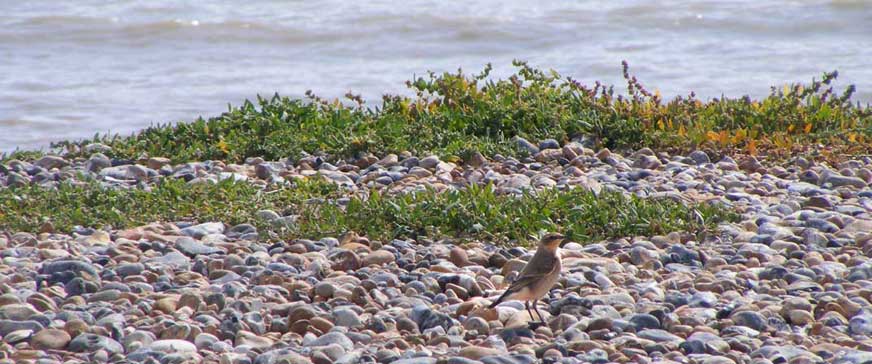| EVENTS
WILDLIFE
REPORTS
30
September 2011
An
early morning visit caught the turn of the tide
which had receded past the Chart Datum Gauge
on Kingston Beach. One notable discovery
was a single specimen of the sea anemone Sagartiogeton
undatus, attached to a pebble
under a boulder. One horizontally striped Ballan
Wrasse,
Labrus bergylta, was
caught in the prawn
net and a few Long-legged
Spider Crabs Macropodia rostrata,
crawled over the black netting. Too tiny to be caught in the net a Worm
Pipefish, Nerophis lumbriciformis,
swam/wriggled next to the Irish Moss
hanging from the metal groyne.
Kingston
Beach Rockpooling Report
29
September 2011
Under
a clear blue sky (>20.3 °C)
an adult Slow Worm
was seen on the path between Nicolson Drive and Rosslyn Avenue in Shoreham.
This may be the first live one I have seen this year.
28
September 2011
On
a (>20.6 °C) sunny
day, a Buzzard
soared in the azure blue cloudless sky
over the downs between New Erringham and
Truleigh
Hill.
Mill
Hill Report
27
September 2011
The
day was not as sunny as forecasted and in the late afternoon a fret
(sea mist) obscured the Shoreham
Harbour Power Station chimney when viewed from Dolphin Road in Shoreham.
The air temperature was 16.0 °C
at 5.00 pm when
the fret occurred. Before the fret the air temperature at 3.00
pm was 17.9 °C.
The south-east
wind speed was 7 mph.
A set fret occurs when when a parcel of warm air passes over the colder
sea.
BBC
Sea Fret Page
Shoreham
Weather
24
September 2011
A
Swallow
was spotted prior to migration.
16
September 2011
There
were brief snatches of sunshine through the gaps in the clouds (>18.7
°C): enough
for a Common Lizard, Lacerta
vivipara, my first of the year, seen
basking on some fallen Chestnut
fencing at the top of the Pixie Path.
As expected in the middle of autumn,
there were frequent Red Admirals
and a few Comma Butterflies
visiting Ivy.
A visit to Mill Hill produced eleven
species of butterfly
in the early afternoon, mostly Meadow
Browns,
but also one of the dainty Small Coppers.
Adur
Lizards
Full
Butterfly Report
11
September 2011
Three
splendid blue South Hawkers
(dragonfly)
were the most impressive sight on a cloudy
day with two around the hedgerows on the road
to Old Erringham and another one over the Pixie
Path to Mill Hill. Ivy attracted
the bees and the butterflies(especially
on the Ivy next to the Pixie Path near the north-west corner of Frampton's
Field) notably Red Admirals
and Comma Butterflies.
Ten
species of butterfly were seen on a day
when
the clouds kept the chill out. Sixty
Meadow
Browns
and
ten male
Adonis
Blues were noted on Mill
Hill.
Full
Butterfly Report
9 September
2011

A Wheatear
trotted
over the Orache-covered
high tide
mark at east Worthing as a prelude to its southerly migration. On
the sand flats opposite Brooklands, halfway
to the low neap water (3 metres), the small 20+ flock of small birds were
not the expected Sanderlings
but
Ringed
Plovers, with a few Grey
Plovers nearer the sea. Later in the afternoon
50+
Lapwings
were seen on the mud flats north of the Toll
Bridge, Old Shoreham.
 |
The
Sea
Purslane, Halimione
portulacoides, is a small greyish-green
shrub abundantly found on the mud flats of the
River
Adur that are even covered twice daily
by the neap tides, but also nearer the high tide
margins. It is a halophyte,
with leaves with a silvery sheen, filled with air (not sap) and the leaves
are dead when the plant reaches maturity.
Halimione
= Daughter of the Sea (Greek) |
6 September
2011
That
gust was too dangerous to cycle in: Gale
Force 7 gusting to Force 9 (52
mph), but only twice in my life have I seen
anything like a gust lasting for just a second (and once I was blown off
my bike whilst walking it). This could be a gust to Storm
Force 10 as reported on the BBC
South Weather News (where they included a gust of 86
mph, Force 12,
at the Needles
on the Isle of Wight).
Met
Office: Shoreham
Shoreham
Weather 2011
2 September
2011
On
the high spring tide the flooded River
Adur looked blue in the afternoon sunshine
(19.0 °C).
At least eighty House Martins
flew low over the river, a few times their beaks appeared to touch the
water surface as if taking a drink. It looked like it was a prelude to
emigration south to Africa.
1 September
2011
On
a warm (>21.4 °C)
day, three
Little Egrets
were seen fishing in the shallows of Widewater
and three more were seen amongst the Sea Purslane
on the Adur mud
flats between the Footbridge and
the Norfolk Bridge.

September
2010
|


